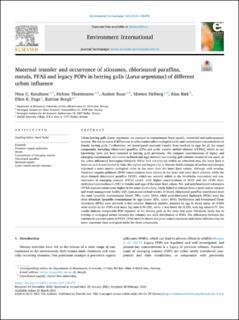| dc.description.abstract | Urban herring gulls (Larus argentatus) are exposed to contaminants from aquatic, terrestrial and anthropogenic sources. We aim to assess if differences in urbanisation affect ecological niche and contaminant concentrations in female herring gulls. Furthermore, we investigated maternal transfer from mothers to eggs for all the target compounds, including chlorinated paraffins (CPs) and cyclic volatile methyl siloxane (cVMSs), which to our knowledge have not been assessed in herring gulls previously. We compare concentrations of legacy and emerging contaminants and metals in blood and eggs between two herring gull colonies located 51 km apart, in the urban influenced Norwegian Oslofjord. While both colonies are within an urbanised area, the inner fjord is more so, as it is surrounded by Oslo, the capital and largest city in Norway Stable isotopes of carbon and nitrogen indicated a more marine ecological niche in the outer than the inner fjord colony, although with overlap. Persistent organic pollutant (POP) concentrations were similar in the inner and outer fjord colonies, while the short-chained chlorinated paraffins (SCCP), which are recently added to the Stockholm convention and contaminants of emerging concern (CECs) varied, with higher concentrations of SCCP and the cVMS decamethylcyclopentasiloxane (D5) in females and eggs of the inner fjord colony. Per- and polyfluorinated substances (PFAS) concentrations were higher in the outer fjord colony, likely linked to releases from a point-source (airport and waste management facility with open access to food waste). In blood, chlorinated paraffins contributed most the total lipophilic contaminants (inner: 78%, outer: 56%), while polychlorinated biphenyls (PCBs) were the most abundant lipophilic contaminants in eggs (inner: 62%, outer: 46%). Dechloranes and brominated flame retardants (BFRs) were detected in few samples. Maternal transfer, assessed by egg to blood ratios, of cVMSs were similar to the POPs with mean log ratio 0.39 (D5), while it was lower for SCCPs, with log ratios-0.77. Our results indicate comparable POP exposure of the herring gulls in the inner and outer Oslofjord, likely due to overlap in ecological niches between the colonies and wide distribution of POPs. The differences between the colonies in concentrations of PFAS, cVMS and CPs shows that point source exposures and urban influence may be more important than ecological niche for these compounds. | en_US |

